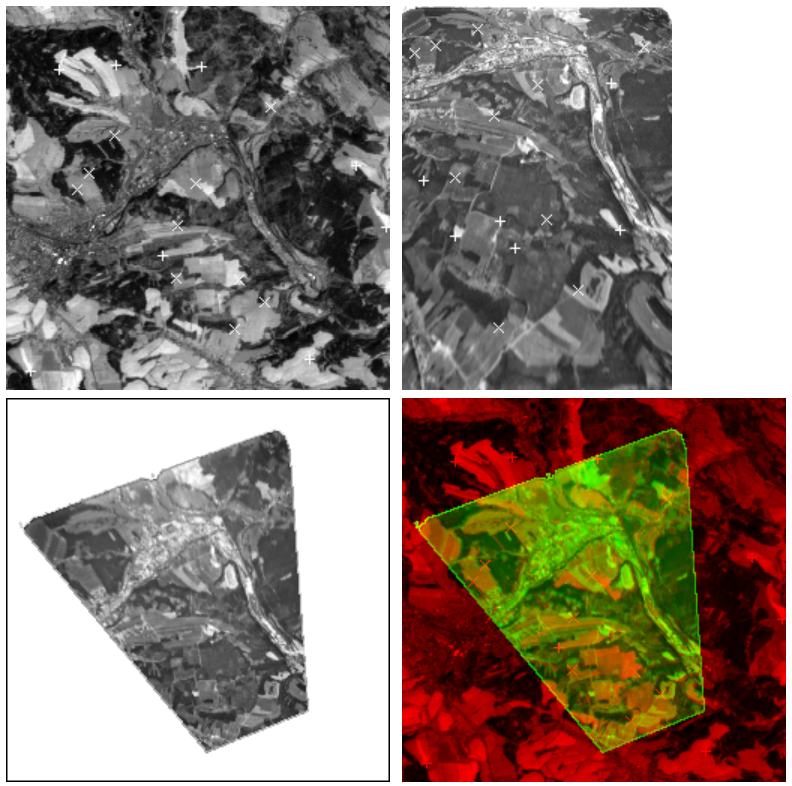Point-Based Projective Invariants are mathematical properties of a set of points that remain unchanged under projective transformations, such as translation, rotation, scaling, and perspective distortion.
Precise invariants with respect to projective transformation of space coordinates
u = (a0 + a1x + a2y)/(c0 + c1x + c2y)
v = (b0 + b1x + b2y)/(c0 + c1x + c2y)
computed from moments does not exist ([9] is probably maximum), that is why projective invariants computed from some other measurements of objects on images are searched. A possible approach is point-based projective invariants. If we can find some significant points in all projectively deformed versions of an object, we can calculate the point-based projective invariant from their coordinates.
If we use some simple version of a cross-product, we need to know sorting of the points. When the correspondences between the points are not known, but the points are vertices of a polygon, then combined invariants to the projective transform and cyclic shift of the vertices is satisfactory. We can utilize also invariants to the projective transform and to the complete permutation of the points. Another approach is computing convex layers of the points. An example of the images registered by this method:

A cut of a Landsat Thematic Mapper image of north-east Bohemia (surroundings of the town Trutnov) from 29 august 1990 (256 x 256 - first image) was registered with an aerial image from 1984 (180 x 256 - second image) with relatively strong projective distortion. 16 points was selected in the aerial image, 18 points was selected in the satellite one, 10 of them have counterparts in the other image (labeled x, the points without counterparts are labeled +). The aerial image was registered by means of projective and permutation invariants (third image) and a color composition of the registered images is shown (fourth image).
Contact person: Tomáš Suk
Publications:
- Suk Tomáš, Flusser Jan: Projective moment invariants, IEEE Transactions on Pattern Analysis and Machine Intelligence vol.26, 10 (2004), p. 1364-1367.
- Suk Tomáš, Flusser Jan: Point-based projective invariants, Pattern Recognition vol.33, 2 (2000), p. 251-261.
- Suk Tomáš, Flusser Jan: Convex layers: A new tool for recognition of projectively deformed point sets, Computer Analysis of Images and Patterns. Proceedings, p. 454-461, Eds: Solina F., Leonardis A., Springer, (Berlin 1999), Computer Analysis of Images and Patterns /8./, (Ljubljana, SI, 01.09.1999-03.09.1999).
- Suk Tomáš, Flusser Jan: Point projective and permutation invariants, Computer Analysis of Images and Patterns, p. 74-81, Eds: Sommer G., Danilidis K., Pauli J., Springer, (Berlin 1997), International Conference CAIP '97 /7./, (Kiel, DE, 10.09.1997-12.09.1997).
- Suk Tomáš, Flusser Jan: Search of the correspondence between the control points for registration of the projectively deformed images, Image and Signal Processing for Remote Sensing, p. 28-37, Eds: Desachy J., SPIE, (Taormina 1996) , Image and Signal Processing for Remote Sensing /3./, (Taormina, IT, 23.09.1996-25.09.1996)
- Suk Tomáš, Flusser Jan: Vertex-based features for recognition of projectively deformed polygons, Pattern Recognition vol.29, 3 (1996), p. 361-367.
- Suk Tomáš, Flusser Jan: The features for recognition of projectively deformed point sets, Proceedings of the IEEE International Conference on Image Processing, p. 348-351, Eds: Werner B., IEEE, (Washington 1995), ICIP '95, (Washington, US, 23.10.1995-26.10.1995)
- Suk Tomáš, Flusser Jan: The projective invariants for polygons, Computer Analysis of Images and Patterns, p. 729-734, Eds: Hlaváč V., Šára R., Springer, (Berlin 1995 , CAIP '95, (Prague, CZ, 06.09.1995-08.09.1995).
- Suk Tomáš, Flusser Jan: Point-Based Projective Invariants, ÚTIA AV ČR, (Praha 1994 Research Report 1812.



